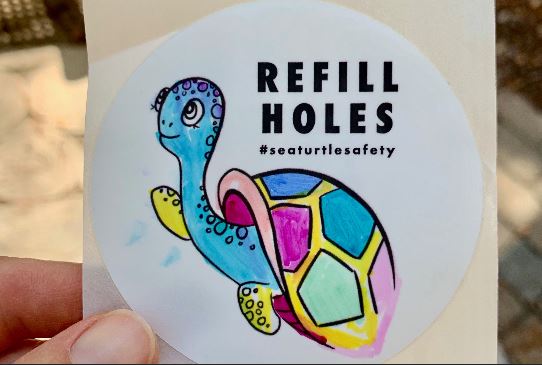TYBEE ISLAND, Ga. (WSAV) — Elementary students on Tybee Island want people to keep these two words in mind before abandoning their sandcastles on the beach: “Refill holes.”
That’s the message for the #SeaTurtleSafety campaign they started in summer 2019, which aims to encourage beachgoers to replace the sand from dug-out holes along the shore.
“This is important because if holes are left behind on the beach, baby sea turtles can get trapped in them as they make their way to the ocean,” Lea Lynch, one of the Tybee residents behind the campaign, told WSAV.
Holes dug up on the beach during sea turtle nesting season could also uncover sea turtle nests, according to Florida’s Loggerhead Marine Life Center.
Baby sea turtles face a number of threats and can have a tough time making it to adulthood, with only an average of one in 5,000 hatchlings surviving to that point.
“This is [a threat] we can collectively eliminate by leaving our beaches nice and flat,” said Caretta Research Project Research Director Dr. Joseph Pfaller.

Lynch and Kelly Swope came up with the idea for the campaign as an opportunity for local children to play a part in solving a coastal community issue.
“The concerns about holes being left behind at the beach is something that we felt elementary-aged students could easily understand,” Lynch said.
“It’s a relatively easy and quick task; the main challenge is just awareness.”
LEA LYNCH, #SEATURTLESAFETY CAMPAIGN
Hatchling sea turtles, in particular, can get stuck in just about any depression in the sand, even a deep footprint or tire track, according to Pfaller.
“When they emerge from their nest at night, hatchlings are pre-programmed to scurry to the ocean as fast as they can to avoid predators,” Pfaller said.
“They are expecting a few bumps and dips here and there, but they are not expecting the deep holes that are sometimes left by beachgoers,” he said.
Any holes left behind make hatchlings and nesting females easy prey for predators, and also leave them trapped and exposed to the potentially deadly heat of the sun.
“The solution to this problem is so easy—refill holes!” Lynch said, adding that remembering to do this on every beach visit can be difficult. The #SeaTurtleSafety campaign hopes to fix that with its “Refill Holes” sticker project.
No hole left behind
The group created weather-proof stickers that could be applied to beach buckets and shovels as a reminder to beachgoers to fill up any holes they dug before heading home.
The group enlisted the help of Sinéad Blanchette, a Savannah College of Art and Design fashion design graduate, to create an original design for the stickers, which the kids then colored themselves.
The #SeaTurtleSafety project was featured at the Tybee Island Farmers Market as the “Kid Biz of the Week” twice over the summer, Lynch said.

“At the first market date, we sold brand-new shovels with stickers on them,” she said. The popular items sold out quickly, she added.
The second time around, they tweaked their approach.
“Instead of selling brand-new shovels, we sold shovels and buckets that had been rescued by the Tybee Clean Beach Volunteers on one of their beach sweeps,” Lynch explained. “So, purchasing a shovel or bucket not only supported the #SeaTurtleSafety project, but it also helped find a new use for discarded beach toys that would have otherwise ended up in the trash.”
They sold out once again, and so far, the campaign has sold over 75 stickers, buckets and shovels.
“In general, [refilling holes] is a relatively easy and quick task, and most people are happy to do it,” Lynch said. “The main challenge is just awareness.”
She says by purchasing a sticker, people are not only giving themselves a reminder, but they’re also educating others who happen to spot their sticker on the beach.
The campaigners are encouraging people with the “Refill Holes” stickers to take photos of them on their beach trip and share them online with #SeaTurtleSafety.
The project has done so well, Lynch said, that they’re now rolling out a national campaign in hopes of reaching coastal communities across the country.
“We will be visiting local area schools over the fall and winter to talk about this project, and provide the opportunity for more students to color stickers for the program,” Lynch added.
The “Refill Holes” stickers are available at SeaTurtleSafety.org.
All profits go toward the Sea Turtle Conservancy to help provide care and support for sea turtles, according to Lynch.










